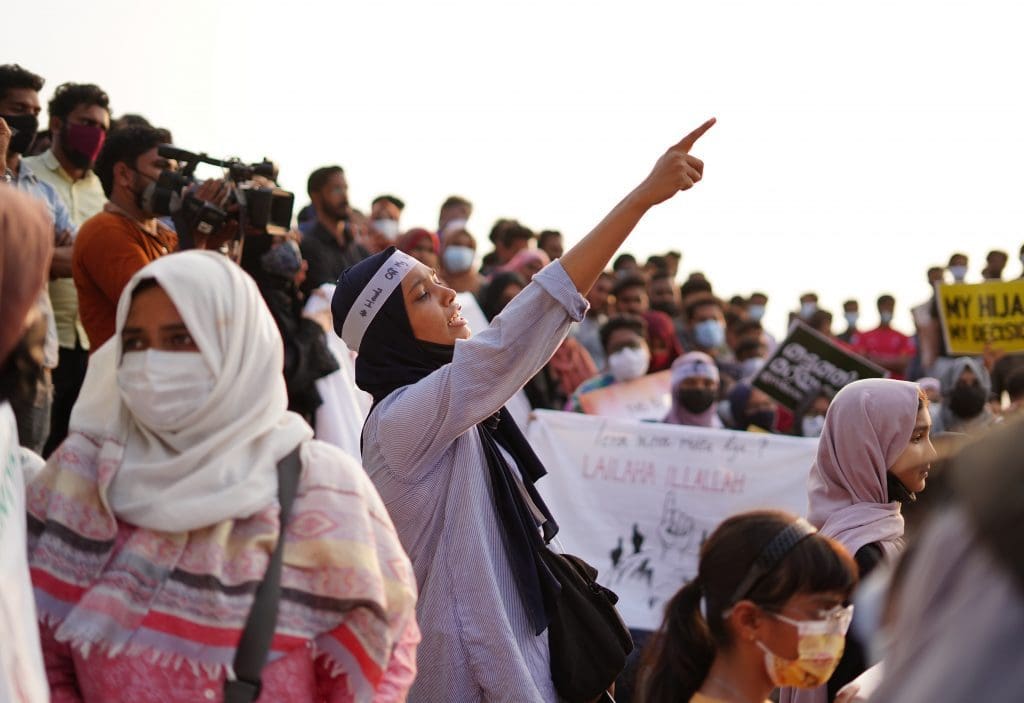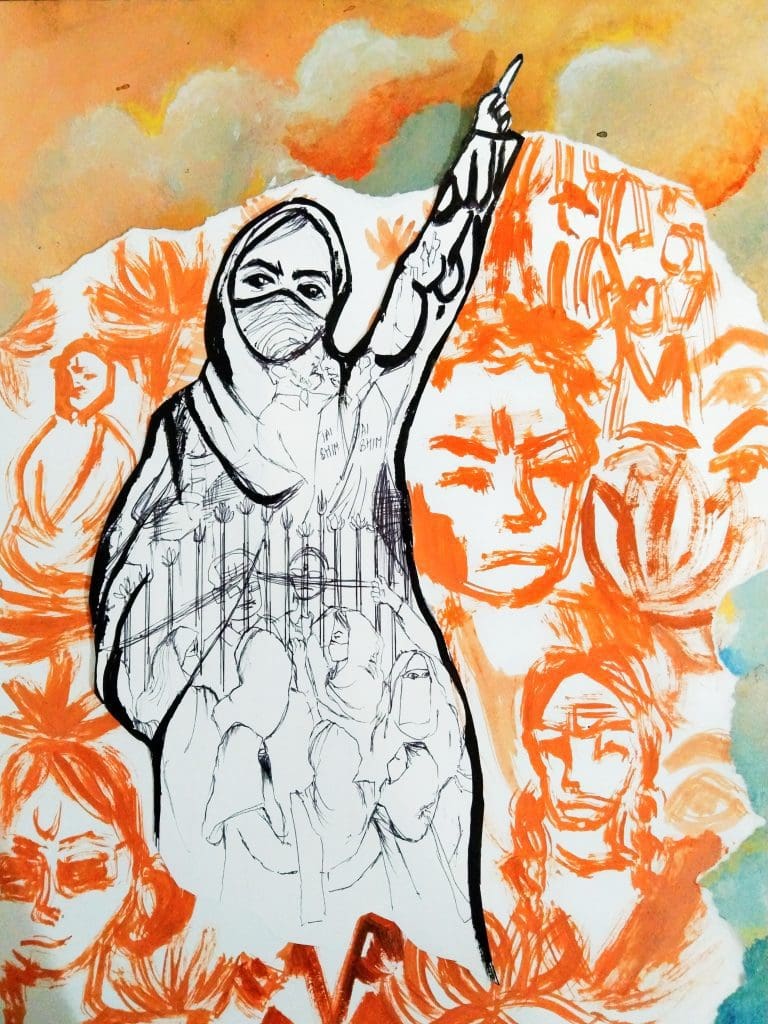
In May 1954 the US Supreme Court in Brown vs board of education ruled unanimously (9-0) that racial segregation in public schools denies equal protection of laws to its citizens. It rejected the ‘separate but equal’ doctrine and declared that separate educational facilities for African American children were inherently unequal. In February 2022, we observe Muslim students in public schools in India are being coerced in separate classrooms and even separate schools, lest they’re willing to give up the hijab.
While some view the hijab to be fundamentally equivalent to saffron shawls and a natural threat to public order and the secular nature of educational institutions, those who advocate in the favor of the choice of Muslim women hopes that one day, they will evolve enough to let go of this piece of attire. Except that, none can enlighten me as to why and how giving up on this piece of attire will lead to my evolution. Except that, it’s been conveniently overlooked that my hijab prejudices your outlook towards me, based upon your belief of my evolution, freedom, intellect and capabilities. Except that, people deliberately ignore that their beliefs of my agency and ability is an outcome of social interactions endogenously produced within the system and rather attribute it to an external cause. Except that it’s not my hijab, but your veiled gazes which produce segregation, stereotypes and stigmas, which in turn reaffirms your belief and inevitably blocks your evolution from this self-confirming feedback loop.
While taste based discrimination, (discrimination stemming out of prejudice) is somewhat condemned, one tends to be completely oblivious of how discrimination can manifest itself as an outcome of supposedly ‘rational’ classification. Glenn C Loury in ‘the anatomy of racial inequality’ describes racial classification as a cognitive act derived from the tendency of Human being to classify people based on irrelevant physical attributes. While physical attributes help to identify a person and classify his social significance it has little to do with the underlying biological factors. The cognitive tendency of Humans to classify on the basis of visible features eventually becomes the norm and powerful meanings are attached to these attributes. In return, once the person realizes that he is being categorized and treated differently on the basis of his physical appearance, he will tend to his appearance, may even get rid of it but he becomes conscious of the fact that he’s being otherized (raced).
My attempt here is not to understand why and how are certain meanings attached to a particular physical trait, but interrogate the argument, that if indeed these attributes are irrelevant signals of one’s productivity, then why has this otherization and eventual discrimination persisted for long. Say for in the case of Muslim women who observes a hijab, a negative perception of her agency has been the norm. Imagine an employer who harbors a prior belief that Muslim women are unlikely to be professional, then when she appears for the job interview donning a hijab and not particularly confirming to conventional ‘formal’ attire, the belief of the employer is validated even if it had nothing to do with her commitment towards the job. Prompted by his prior belief, the employer then subconsciously sets a lower threshold for Muslim woman to err as compared to other candidates. Muslim Woman upon realizing that they’re being stereotyped for the outfit or religion, then becomes conscious of her identity and is unlikely to realize her full potential. This response in turn validates the prior belief of the employer and generates a loop of self-confirming norms. Stereotypes harbored against a particular group substantiates itself and due to limited information, an equilibrium emerges where beliefs and behavior are consistent with each other. The problem arises when such instances are generalized to form rigid negative perception about a particular group which Loury ascribes as ‘biased social cognition’. Here to a particular employer, hijab only conveys the message that he expects to receive. However, it is unjust and extremely problematic to attribute the effect of an interaction produced within the system to an exogenous cause. Loury describes biased social cognition to be ‘a politically consequential cognitive distortion to ascribe the disadvantage to be observed among a group of people to qualities thought to be intrinsic to that group when, in fact, that disadvantage is the product of a system of social interactions.’ When the said group happens to be Muslims in India, this biased social cognition is even more rigid.
The question then arises, that aren’t their mechanisms in place to alter this distorted system of interaction? People can perhaps update their beliefs, however, that requires one to first subject their belief to scrutiny. If this discrimination against hijab clad women doesn’t strike the observer as being unfair and disturbing, if he’s unwilling to acknowledge where he stands in the power hierarchy and fails to accept how his own attitude has kindled the problem, he is unlikely to revise his belief. Consequently, the arbitrariness of attaching the physical appearance of Muslim women to her agency or ability remains unanswered and we remain confined within this obsolete system.


These physical markings are not only arbitrary indicators of one’s worth but also has its bearing on the identity, belongingness and segregation of a particular group. When hijab becomes the instrument to isolate and discriminate, the negative connotation ascribed to the hijab occupies the public imaginations. Observers misattribute lack of Muslim women in educational institutes, corporates, public institutions, government offices and especially the media to be intrinsically and solely linked to the hijab and the meanings associated with it. Given that the Hijab is a marker unique to Muslim women it reasserts the us vs them binary in the mind of the observer. These meanings can remain persistent and unchallenged for generations to come and the stigmatized group in question suffers from ‘spoiled collective identity’. This again is both an outcome of, and perpetuates biased social cognition where the idea that Muslim women observing the hijab lack agency and ability becomes the uncontested norm. When stigma arises, negative meanings associated with the hijab are predominant, people view them with disdain and scornful gaze. Not surprisingly this translates into a severe consciousness of one’s identity, associated with belonging to the stigmatized other. Segregation and stigmatization perhaps explain why inequality based on stereotypes have survived over time. The underlying structure upon which this system is rooted barely comes under scrutiny and people remain oblivious (deliberately or otherwise) to the ways in which it can be undone.
The proposition that Muslim women should evolve themselves, puts the onus of the problem upon the marginalized group. This lack of empathy and deliberate attempt to avoid an introspection of one’s belief, reproduces discrimination and inequality. System wide intervention to uncover the true cause of disparity is required to break this vicious circle and help overcome this persistent inequality against Muslim Women in India.
Khadija Aslam is a PhD student at Delhi School of Economics.



